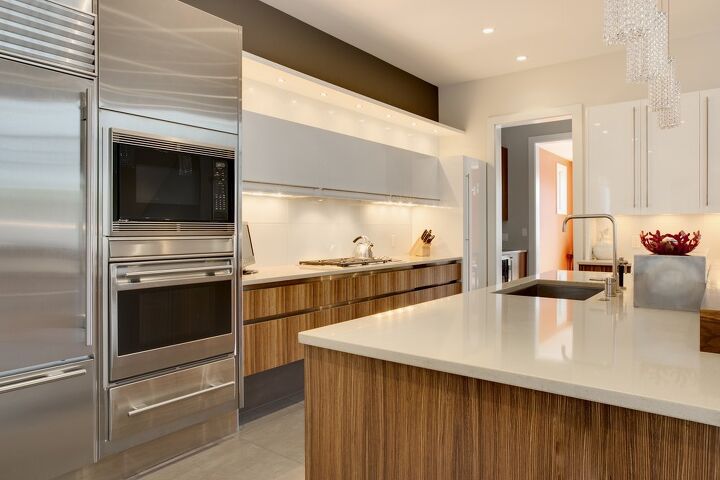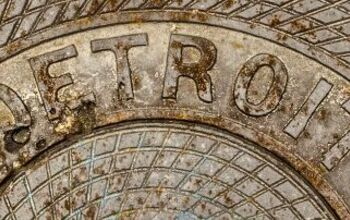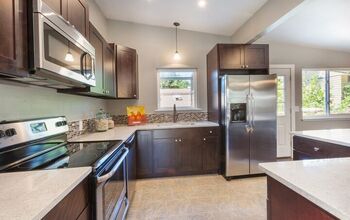What Are The Pros And Cons Of Bamboo Cabinets?

Bamboo is making a name for itself in the sustainability community. It has become an increasingly popular choice for building materials, and household cabinetry is no exception. If you’re looking for a unique, eco-friendly upgrade for your kitchen, look no further than bamboo.
Highly durable and stronger than some hardwoods, bamboo cabinets are the epitome of the contemporary, minimalist style. It is an easy to clean, scratch-resistant, and sustainable material due to its quick regeneration.
Because they still aren’t the mainstream choice, bamboo cabinets tend to be more expensive with fewer style options available. They can cost anywhere between $12,000 and $20,000 for the average kitchen.
Let’s explore all the advantages and disadvantages that bamboo has to offer for your kitchen or bathroom cabinets.
Do You Need to Hire Cabinet Installers?
Get free, zero-commitment quotes from pro contractors near you.

An Eco-Friendly Option
Often thought of as a species of wood, bamboo is actually a very sturdy grass. In fact, wood is being replaced by bamboo more and more often because of its sustainable nature.
It’s no secret that bamboo grows quickly. In my first house, a neighbor to my backyard planted bamboo. I moved after a year and it had made its way about a foot from my patio. When used for building materials, however, its quick regeneration is a huge benefit.
Bamboo can be harvested every 3-5 years. The top of the stalk is harvested which allows the bottom to grow that much quicker. Compared to trees that die after harvesting, bamboo regenerates after 3 years. Its rapid growth means it can be used faster and more often than the hardwood of trees.
Bamboo Treatments
In order to construct cabinets from bamboo, the material needs to be treated in one of two ways. It can either be laminated or strand-woven.
For the laminated option, vertical bamboo slats are fused together through heat and pressure to form sheets. These sheets are cut to a dimension similar to plywood. They can be solid bamboo panels or bamboo plywood. The latter is when a thin surface of bamboo is laid over traditional wood.
Strand-woven bamboo looks closer to traditional wood. For this option, the stalks are pulverized, and the pulp is formed, glued, and compacted into planks. Strand-woven bamboo is generally harder than laminated bamboo. It’s typically used as a flooring option.
Sleek Lines
Whether the panels are laminated or strand-woven, bamboo cabinets are created from simple, straight frames and panels. Their Shaker-style doors and sleek lines are the stuff of a minimalist’s dreams.
Bamboo cabinets fit the modern, contemporary aesthetic. They also give a slight nod to the streamlined style of the midcentury but without the Formica.
Janka Hardness Rating
Even though bamboo is not wood per se, it’s still rated like wood by builders because of how frequently it’s substituted.
Bamboo is as hard or harder than oak and maple. In its natural state, bamboo has a Janka rating of 1300-1400. For comparison, red oak is rated at 1290, white oak at 1360, and maple at 1450.
All of this is to say that bamboo makes for a durable material, perfect for high-use areas, such as a kitchen. It won’t easily scratch, crack, or warp. You can also apply a protective coating to add to its durability.
The Colors of Bamboo
The natural hues of bamboo are warm and neutral. Without treatments, it appears in blonde and honey tones, and its linear grains are highlighted.
One of the most common treatments of bamboo is to leave it unstained and add a waterborne finish. This type of finish makes for a scratch-resistant surface and is also eco-friendly. You can also use a natural or water-based finish to protect the bamboo.
Leaving bamboo unstained enhances the modern aesthetic. Its natural color adds warmth and character to what can be a cold and sterile style. The stark, clean lines are offset by the coziness of its natural color.
On the other hand, bamboo takes stains well. A darker stain can make the space feel more luxurious. Depending on the type of stain, the cabinets make take on the look of being multi-toned. This could make a real statement for your space, but it’s definitely a conscious style choice.
Bamboo Cabinet Maintenance
Bamboo cabinets are relatively low maintenance. Because of their durability, not much needs to be done to protect it from everyday wear and tear. They don’t usually need to be refinished. However, it is important to note that bamboo will scratch if treated roughly.
Cleaning bamboo is easy. You only need warm, soapy water and a soft cloth. With the exception of sealing it yourself, it doesn’t require oils like most hardwoods.
Humidity-Resistant
Over time, wood tends to warp as humidity levels change. This is not the case for bamboo. It can withstand changes in humidity levels without warping. In addition, bamboo shelves will never sag and the drawers will always stay in alignment.
Low-Demand
Bamboo is replacing wood more and more, but it’s still not a mainstream choice for cabinetry. Because of its lack of popularity, size and style options are limited.
Before you decide on bamboo, it’s very important to accurately measure your space. This will ensure the proper cabinet sizes are available for your needs. If not, you may require custom cabinets.
The Cost of Bamboo Cabinets
Because they are not a popular choice and therefore less available, bamboo cabinets tend to be more expensive than hardwood. For an average kitchen, bamboo cabinets can cost $12,000-$20,000. For premium bamboo, it can cost upwards of $35,000.
Bamboo is generally heavier than traditional wood, which can add to transportation costs and diminish its eco-friendliness.
To lower the cost of bamboo cabinets, you can opt for bamboo plywood instead of solid bamboo cabinets.
Bamboo Cabinet Pros and Cons
Laying out the pros and cons is an important part of decision-making. Here are the good, the bad, and the ugly of bamboo cabinets to help determine if they’re right for you.
| Pros | Cons |
| Eco-friendly, sustainable option | Limited style and size options due to low-demand |
| Highly durable and able to withstand scratches, cracks, and changes in humidity | Custom cabinets may be required, adding to the overall cost |
| As hard or harder than some hardwoods | Expensive compared to traditional hardwoods |
| Easy to clean and maintain | Due to its weight, transportation costs can be high which negates some of its sustainability |
| Takes stains well but can also be left natural | Staining can add an unwanted multi-tone |
| Simple and sleek design enhances modern style | Will scratch under rough treatment |
Related Questions
We discussed the basics and beyond about bamboo cabinets, but you may still have more questions. Here are some other things people wondered about the pros and cons of bamboo cabinets.
Is bamboo good for a bathroom vanity?Though it won’t take as much wear as a kitchen cabinet, a bamboo vanity is a great choice. Most bathroom vanities are made from particleboard, so a bamboo vanity would be a much more durable option. When used in a bathroom, bamboo can inspire a beachy or Asian style.
Is a bamboo sink a good idea and how do you maintain it?Bamboo is naturally water-resistant, and its high durability makes for a great sink option. To clean a bamboo sink, use mild soap, water, and a soft sponge or cloth. You can also use one ounce of vinegar to one quart of water as a cleaning solution. Avoid ammonia-based and other harsh chemicals as they can damage the bamboo.
Can bamboo be painted?Although bamboo can be painted, a less expensive, hardwood option might be a better choice for that treatment. Many people choose bamboo specifically for its unique look which can be enhanced by staining. Painting bamboo would take away from its modern look.
What do you seal bamboo with?Bamboo can be sealed with the following things: mineral oil, linseed oil, tung oil (also called Chinawood oil), teak oil, beeswax, or varnish. Both mineral oil and beeswax are food-safe options. However, tung oil is by far the most durable finish. It hardens when it dries, sealing moisture into the bamboo and making it waterproof. Tung oil also doesn’t darken with age like linseed oil or beeswax. Three or four coats of tung oil are enough for cabinets.
Do You Need to Hire Cabinet Installers?
Get free, zero-commitment quotes from pro contractors near you.

Summing It Up
A beautiful, sustainable option for your modern kitchen or bathroom, bamboo cabinets offer a sleek and unique style.
Bamboo cabinets have many pros. Not only are they eco-friendly, but they are highly durable, even more so than some hardwoods. Low maintenance and easy to clean, bamboo cabinets can withstand scratches, cracks, and humidity. They accept stains well or can be left in their warm, natural state.
The downside of bamboo cabinets would be their cost and availability. Not enough people are in the market for bamboo cabinets. This makes style and sizing options limited, which in turn, drives up the price. Bamboo cabinets cost anywhere between $12,000 and $20,000 or $35,000 for top quality bamboo.
If you can afford them, bamboo cabinets are an excellent addition to the modern, minimalist aesthetic. On top of that, you can sleep well knowing your cabinets are helping the environment.

Brigid Levi is a wife, mother, and freelance writer who enjoys a good DIY project and creating beautiful spaces within her home. From cleaning and organization hacks to home decor ideas, she loves helping people in their quest to turn a house into a home. Her hobbies include pretending to be Joanna Gaines while updating her home with her husband and performing in local theater productions.
More by Brigid Levi



























